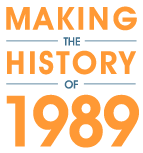Primary Sources
Browse Items
Women’s Reflections on Food Rationing in the 1980s
During a series of oral history interviews conducted in Braşov, Romania, during the summer of 2003, “S” and “M” discuss the various strategies they used to procure food and concoct meals for their families during the period of rationing in the 1980s. Meanwhile “E” offers insight into Romanian hospitality, stressing that even in the midst of mass shortages, women managed to lay out….
Vending Machine
In the United States coin-operated drink machines - generically called "coke machines" - are ubiquitous consumer objects regularly punctuating our everyday landscapes. We feed them our money and out roll individually packaged liquid refreshments. During the last years of the Cold War designers in the East Bloc developed their own regional version of the "coke machine". It did not sell….
Rude Pravo, Central Committee Meeting
In 1978, one year after the creation of Charter '77, Vaclav Havel wrote his famous essay, "The Power of the Powerless." In it he argued that the countries of the East Bloc were under the rule of post-totalitarian regimes that appealed to popular desires for consumer goods, in order to secure domination over their populations. Indeed, these governments did make consumerist appeals. But they….
Samizdat, Tuzex
Tuzex, short for Tuzemský export (or domestic export), was a set of special stores in Communist Czechoslovakia. The Communist Party established Tuzex in 1957, in order to draw hard currency from citizens' pockets into the coffers of the state. Hard currency, including American dollars and West German marks, was convertible currency linked to the international gold….
Samizdat, Five Year Plan
In 1986 the Czechoslovak Communist Central Committee approved its Eighth Five Year Plan since 1948, which stayed in effect, with modifications, until 1990. The plan built upon the East Bloc practices of following the Soviet command-economy model and emphasizing heavy industry over consumer goods. For example, the plan called for industrial output to grow 15.8% for the five year period (roughly….
Samizdat, Consumer Goods
Czechoslovaks watched the unfolding of perestroika [restructuring] in the Soviet Union and its slow introduction into their own economy with great interest, although there were obstacles to doing so. While the Czechoslovak Communist Party was ready to start experimenting with economic perestroika, it maintained reservations about glasnost [openness or publicity]. It suppressed reports about….
Shopping queue in Wrocław
Upheavals in political, economic, social, and cultural conditions in the 1980s led to many challenges in everyday lives of average citizens of East European countries. Buying such necessities as food, clothing, and hygiene products posed serious difficulties to consumers. Store shelves were frequently empty and lines that took as long as several hours to navigate were common. In this 1982….
The Butcher Shop, Warsaw
In the 1980s average citizens of East European countries faced many challenges, including daily difficulties created from ongoing and severe shortages of consumer goods. Buying such necessities as food, clothing, and hygiene products was a recurring obstacle to average consumers. Store shelves were frequently empty, and the state distributed ration cards, especially for meat products, in an….
